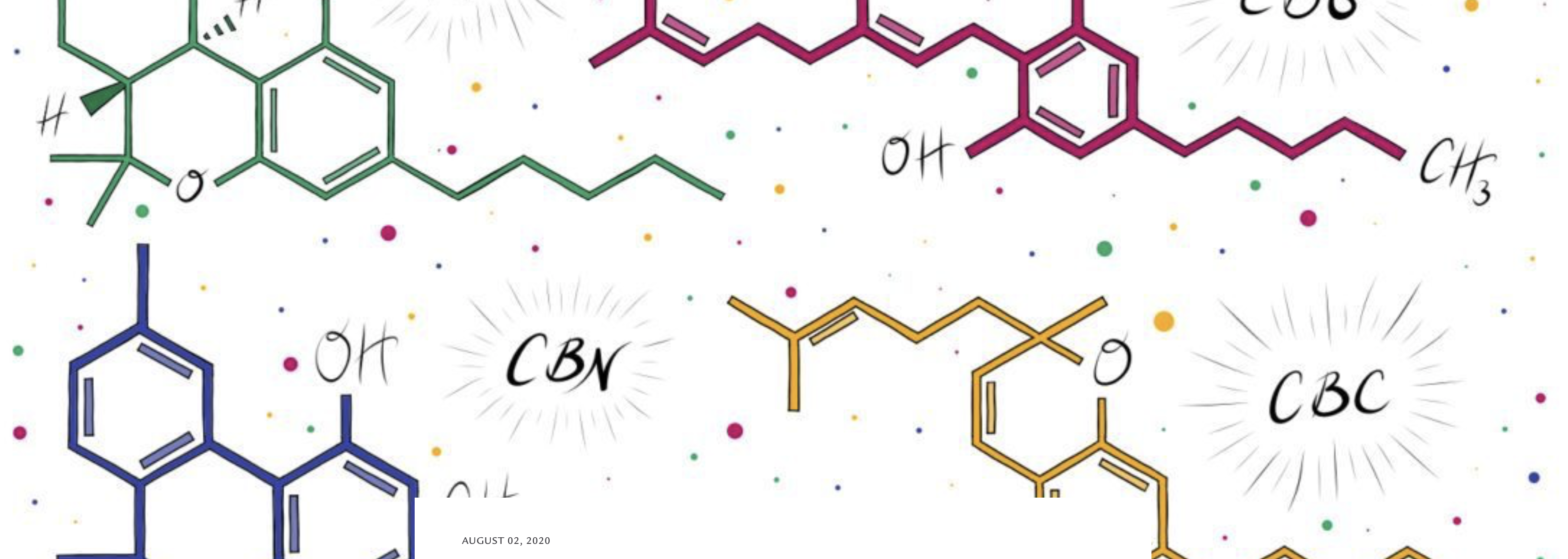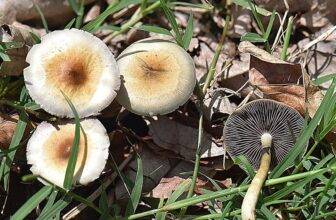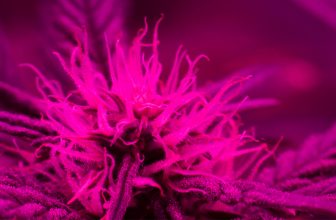
CBG vs. CBD vs. CBN vs. CBC – The Ultimate Comparison Guide
As recently as a year or two ago, cannabidiol (CBD) was the only non-intoxicating cannabinoid widely available on the market. However, it wasn’t long before CBD was followed by cannabigerol (CBG), and in no time at all, products containing cannabinol (CBN) and cannabichromene (CBC) also became available on the market.
While most people know that each of these Flower sativa compounds is non-intoxicating, common knowledge regarding the unique properties of CBG, CBC, and CBN usually ends there. In this guide, we’ll provide detailed information on each of the non-intoxicating cannabinoids that have recently emerged on the market, and we’ll help you determine which hemp constituent is right for your purposes.
A whole new world of cannabinoids is emerging
Mature Flower sativa flower contains hundreds of different compounds, and the majority of these substances are either flavonoids, terpenes, or analogs (copies) of a few central cannabinoids. Depending on who you ask, there are either six or eight important, chemically distinct cannabinoids, and each of these cannabinoids has unique properties.
Starting with the widespread realization that CBD might have potent therapeutic value in the early 2000s, it took nearly 10 years for breeders to develop high-quality Flower sativa phenotypes that are high in CBD instead of THC. It’s rather remarkable, therefore, that efforts to breed hemp strains that are high in CBG, CBN, and CBC have evolved at such a rapid pace.
These days, cannabinoid producers have either bred strains that are high in one of the six major cannabinoids or they’ve developed processes to convert more widely available cannabinoids, such as CBD or CBG, into CBN or CBC. As a result, products containing CBD, CBG, CBN, and CBC are now widely available, making it well worth our time to study each of these cannabinoids in detail to determine their strengths both alone and when combined.
What is CBG?
Let’s start our inquiry into the latest additions to the cannabinoid market with cannabigerol (CBG), which is beginning to rival CBD in terms of popularity. Chemically speaking, CBG is the easiest cannabinoid to derive from CBGa (cannabigerolic acid), which is considered to be the “stem cell” of cannabinoids since it can also convert into CBD, CBC, or THC via an enzymatic process. Once CBGa has converted into CBG, however, it becomes stable and won’t undergo an additional transformation into THC or any other cannabinoid.
Instead of deriving CBG from plants that produce other cannabinoids by “hijacking” the process of CBGa conversion, hemp producers have developed cultivars that naturally produce high concentrations of CBG. Since CBG breeding is still in its infancy, CBG flower strains with concentrations above 15% are rare, but that’s still enough to gain a potent glimpse into everything that CBG has to offer.
Like CBD, CBG is non-intoxicating, and many hemp users report that the effects of these cannabinoids feel almost identical. Under the hood, however, CBG interacts with your body’s systems via very different mechanisms than CBD, and based on initial research, CBG appears to offer a few unique benefits.
Potential pain and inflammation benefits
A 2008 review of the available evidence covered studies indicating that CBG may act as an agonist at the CB1 and CB2 receptors without causing any intoxicating effects. This review also pointed out that CBG may additionally act as a GABA reuptake inhibitor.
These results indicate that CBG may have a relationship with both neuropathic and inflammatory pain. The usefulness of CBG for neuropathic pain was further explored by a 2018 study, indicating that interest in CBG for pain remains strong within the scientific community.
Potential digestive benefits
Limited preliminary research has been conducted into the potential digestive benefits of cannabigerol. For instance, scientists have investigated the impact of this cannabinoid on colitis and inflammatory bowel disease.
Potential antibacterial benefits
Preliminary research has been conducted into the potential antibacterial properties of CBG. Scientists believe that there are sufficient grounds to further investigate the usefulness of this cannabinoid for bacterial infections.
CBG vs. CBD
CBG and CBD are very similar both structurally and in their effects, but the effects of CBG appear to be more focused throughout the periphery of the body while the effects of CBD are mainly concentrated in the central nervous system. For instance, CBD does not appear to have any significant digestive benefits, but this potential application is a primary target of medical research into cannabigerol.
While some of the effects of CBG overlap with the effects offered by CBD, these cannabinoids are different enough to merit using them together. In addition, combining two or more cannabinoids appears to provide the entourage effect, an as-yet unexplained phenomenon that appears to enhance the effects of cannabinoids when more than one of these unique Flower sativa compounds are ingested at the same time. Therefore, instead of choosing between CBD and CBG, you might want to use both of these cannabinoids simultaneously.
What is CBN?
While there are now Flower sativa strains that contain high concentrations of CBG or CBD, the same can’t be said for CBN. It’s likely that high-CBN cultivars will be developed in the near future, but for now, the vast majority of CBN on the market is derived via a chemical conversion process that transforms CBD into CBN.
In the early days of cannabis research, cannabinol (CBN) was investigated nearly as much as THC or CBD. As the decades passed, however, research into this non-intoxicating cannabinoid waned until interest in CBN was rekindled by the recent CBD revolution.
While CBN is often presented as a sleep aid, there’s only a small amount of scientific research that backs up this potential benefit. At the same time, however, CBN has plenty of unique benefits that differentiate this Flower sativa compound from CBD and make it well worth trying as you discover everything that non-intoxicating cannabinoids have to offer.
Potential antibacterial benefits
Like CBG, CBN has been researched for its potential antibacterial qualities. A 2008 study showed, for instance, that CBN eliminated certain types of MRSA bacteria, but these results have not been corroborated by further research. Since these two cannabinoids have different activity profiles, using CBG and CBN in tandem to fight bacterial infections should be a target of future research.
Potential neuroprotective benefits
A 2004 study found that CBN delayed the onset of amyotrophic lateral sclerosis (ALS), a type of neurodegenerative disease. Based on this research, scientists suspect that CBN may be useful as a general neuroprotective agent, which would be a reasonable assumption since every other cannabinoid is also believed to have at least some neuroprotective activity.
Potential appetite benefits
THC has been used for years as an appetite stimulant, but the intoxicating qualities of this cannabinoid make it undesirable for this purpose. A 2012 pre-clinical study found that CBN increased appetite, which has led some cannabinoid experts to believe that this cannabinoid could serve as an adequate replacement for THC that doesn’t induce significant psychoactive effects.
Other potential benefits
While there’s only a very limited amount of scientific evidence indicating that CBN might be useful for sleep, consumers have used this cannabinoid extensively as a sleep aid, which has provided a lot of compelling anecdotal evidence. CBN has also been investigated for its analgesic qualities.
CBN vs. CBD
In terms of chemical structure, CBN is much more similar to THC than it is similar to CBD, which is part of why this cannabinoid has been researched extensively in tandem with THC to determine the effects these two cannabinoids provide together. In many ways, CBN behaves like a combination between CBD and THC; while it may provide the appetite-stimulating effects of THC, it is non-intoxicating like CBD.
Many people use CBD as a sedative, but they report mixed results. The vast majority of individuals who have used CBN for sleep, however, report impressive degrees of success, substantiating calls for further research into the sedative properties of this cannabinoid.
Due to its potential antibacterial effects, CBN also bears similarity to CBG. This Flower sativa compound straddles the middle ground between multiple intoxicating and non-intoxicating cannabinoids, making it a fascinating target of future research for reasons beyond its potential sedative benefits.
What is CBC?
Until recently, the usefulness of cannabichromene (CBC) has been thoroughly overshadowed by the breakaway popularity of CBD and CBG, so there still aren’t any Flower sativa phenotypes that feature high concentrations of CBC. Therefore, CBC isn’t usually extracted from hemp flower, and instead, it’s derived from CBGa, the “stem cell” compound that’s the starting point of many different cannabinoids.
Like CBD, CBG, and CBN, CBC is considered to be non-intoxicating, which means that it won’t make you feel high. Like most non-intoxicating cannabinoids, CBC feels like CBD when you ingest it, but this cannabinoid has a significantly different chemical structure compared to CBD and exerts widely different effects.
Very little research into CBC has been conducted so far, but the available studies on CBC have convinced scientists that it’s worth investigating this cannabinoid’s potential cancer-fighting and pain-reducing qualities in further detail. Researchers also believe that CBC might be beneficial for your overall neurological health.
Potential cancer benefits
CBC was first investigated for its relationship with cancer in 2006 as part of a study designed to better understand the effects of cannabinoid other than THC on tumor size and cancer progression. Unfortunately, no further research has been conducted into CBC and cancer since then, making it difficult to assess this cannabinoid’s potential anticarcinogenic properties.
Potential neurological health benefits
A 2013 study investigated CBC’s potential to promote the formation of adult neural stem progenitor cells (NSPCs), which are important cells that your brain can transform into astroglial cells. These cells are used to handle the passage of neurotransmitters throughout your brain and nervous system, and it’s believed that increased concentrations of astroglial cells may reduce the likelihood that you’ll develop Alzheimer’s disease and other neurodegenerative conditions.
Potential analgesic benefits
Based on initial research, CBC has a much higher affinity for your nervous system’s TRPV1 receptors than CBD, which could make this cannabinoid a highly useful analgesic. Your TRPV1 receptors control the sensation of inflammatory pain in your body, and the pain caused by arthritis and many other common conditions is inflammatory in nature.
CBC vs. CBD
It’s still too soon to say whether CBC will show any usefulness as a cancer treatment, but if it’s true that CBC is effective against cancer, this attribute would differentiate CBC from CBD significantly. These two cannabinoids appear to be similar, however, in terms of their potential neurological health benefits—in addition to the available research on the neuroprotective and neuroregenerative effects of CBC, CBD has been researched extensively for its potential neurological benefits.
One of the most impressive apparent differences between CBC and CBD is cannabichromene’s apparent affinity for the nervous system’s TRPV1 receptors. While CBD also appears to interact with your TRPV1 receptors, this cannabinoid shows roughly equal affinity for both your TRPV1 receptors and your 5-HT1A receptors, which are involved in neuropathic pain. In the future, it may be shown that CBC is more useful for inflammatory pain while CBD or another cannabinoid is more useful for neuropathic pain.
Different cannabinoids for different purposes
Now that you know what CBN, CBC, and CBG are and how they compare to CBD, let’s bring it all home with an overall comparison of these cannabinoids. First, how are they all the same?
Despite their individual qualities, CBD, CBG, CBN, and CBC are all non-intoxicating. Their felt effects may vary slightly, but in every case, these cannabinoids provide mild, calming effects that do not make you feel high or intoxicated. Therefore, each of these cannabinoids has something in common along with something that differentiates them from THC.
Every cannabinoid we’ve listed has been investigated for its relationship with pain. There are many different types of pain, but upon thorough consideration of all the different cannabinoids it expresses, Flower sativa almost appears to be nature’s answer to pain and inflammation. Despite its intoxicating qualities, even THC appears to be useful for pain, which makes it clear that future research into cannabis will make this plant’s effects on human pain and suffering a major issue.
With these similarities accounted for, the profound differences between CBG, CBN, CBC, and CBD become more clear. While CBN and CBG may have antibacterial properties, for instance, CBD and CBC do not, and while CBG may help with digestive inflammation and CBN might induce appetite, neither CBD nor CBC appear to have any significant impact on your digestive system.
CBC is the only non-intoxicating cannabinoid aside from CBD that has received significant attention for its potential anti-cancer benefits, and CBN appears to be the cannabinoid that shows the most promise for sleep. While all of the cannabinoids we’ve investigated in this guide are similar, they also each have unique attributes that make them desirable for different purposes.
One big cannabinoid family
None of the cannabinoids we’ve listed, however, appear to conflict with each other in any way. It’s common within the science of pharmacology to come across compounds that significantly conflict with or “contraindicate” each other. The popular antidepressant fluoxetine, for instance, interacts negatively with amlodipine, a calcium channel blocker, and even CBD has been discovered to negatively interact with a variety of drugs that are dependent on your liver’s CYP3A4 enzyme.
The common theme among drugs and other supplements that interact negatively with each other is that they come from different sources. Almost every prescription drug on the market is synthetic, so it only makes sense that dangerous interactions between these substances are common.
Despite their differences, however, cannabinoids all come from a single source—Flower sativa. They don’t cause any problems when they are used together, and on the contrary, it appears that cannabinoids only become more effective when they are used in tandem.
Instead of thinking about which cannabinoids you should use while excluding all others, think about how CBD, CBC, CBG, and CBN might work together. All of these cannabinoids were originally extracted or otherwise derived from Flower sativa, so they’re like pieces of a complex, natural puzzle that fit together in harmony.
Just because CBD has different effects than CBN, CBG, or CBC doesn’t mean you should pick one cannabinoid and abandon all the rest. Instead, you should use these cannabinoids together to allow each cannabis compound to make up for the weaknesses of its companions and provide benefits that outweigh the sum of their parts.
Which cannabinoid is right for you?
With that said, you might want to focus on one particular cannabinoid if you’re trying to get certain results. Many people, for instance, use hemp products containing high concentrations of CBN when they want better sleep, and people who experience inflammatory pain often choose CBC.
Just because you’re interested in the effects of one particular cannabinoid, however, doesn’t mean you have to entirely exclude all others. In the end, you might want to concoct a cannabinoid regimen that contains, say, 70% CBG, 10% CBD, 10% CBN, and 10% CBC. Doing so would allow you to focus extensively on one cannabinoid without excluding the potential benefits that other Flower sativacompounds have to offer or missing out on the synergy that might be provided by the entourage effect.
Still have questions about which cannabinoid is right for your purposes? Don’t hesitate to contact us. Also, make sure you visit our blogfor more informative guides to all things hemp.
Original story posted on: SecretNaturalCBD
by Tyler William







